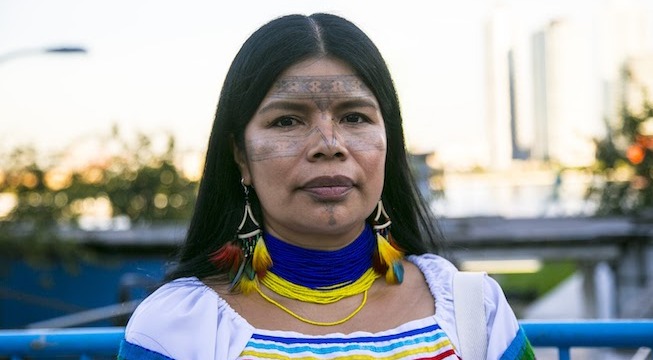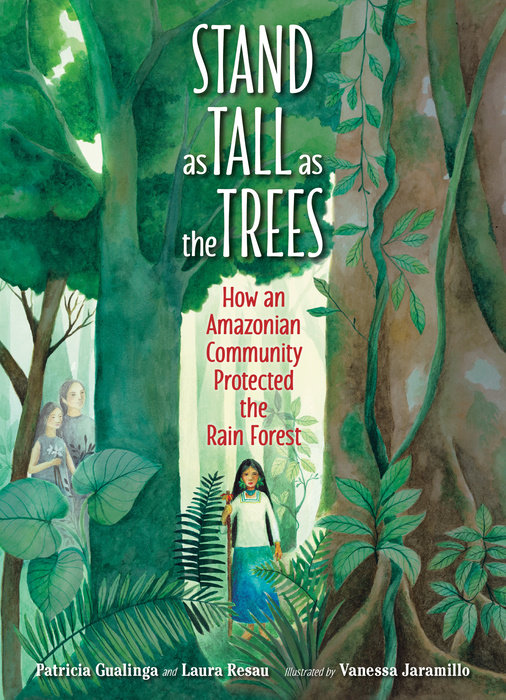Patricia Gualinga, Indigenous Leader from Sarayaku, Publishes New Children’s Book
 Patricia Gualinga, a leader of the Kichwa village of Sarayaku in the Ecuadorian Amazon, recently published Stand as Tall as the Trees: How an Amazonian Community Protected the Rain Forest (or Con La Cabeza en Alto: Cómo una comunidad amazónica protegió la selva tropical,” the original title in Spanish), a children’s book that tells the story of her community and their efforts to protect the Amazon rainforest.
Patricia Gualinga, a leader of the Kichwa village of Sarayaku in the Ecuadorian Amazon, recently published Stand as Tall as the Trees: How an Amazonian Community Protected the Rain Forest (or Con La Cabeza en Alto: Cómo una comunidad amazónica protegió la selva tropical,” the original title in Spanish), a children’s book that tells the story of her community and their efforts to protect the Amazon rainforest.
Patricia has been on the frontlines of her community’s struggle and resistance against extractive industries encroaching on their rights and their lands for oil development. She has been a powerful advocate for Indigenous rights and the rights of nature, bringing international attention to the struggles of her people and those of other Indigenous communities fighting to protect the Amazon.
For years, the Sarayaku community worked with other Indigenous groups to bring the Ecuadorian government to the Court of Human Rights for violating their rights by initiating oil development in their territory without their free, prior, and informed consultation and consent. In 2012, the Court ruled in favor of Sarayaku, representing a historic moment, but the work to protect the Amazon didn’t stop there. Sarayaku and other Indigenous communities and nationalities continue to fight for their rights and the preservation of their ancestral lands.
Earlier this month, Pachamama Alliance team member Shi Woo Ji had a chance to ask Patricia about her inspiring new book, which is now available for purchase online and in select bookstores.
Shi Woo Ji: What inspired you to write this book, and specifically for children?
Patricia Gualinga: I was inspired by the teachings of my grandmothers, by the teachings of my father and my mother about the defense of nature, our connection with nature, and the care that we should have [for nature]. And I was also inspired by the struggle and resistance of the people of Sarayaku and the lives of Indigenous women. [I was] also [inspired by the] impact that [the Sarayaku people] had when we went out into global society.
Shi Woo Ji: What are some of the key messages you’d like children—or anybody else—to get from reading your book?
Patricia Gualinga: A love of nature and that we have to take care of nature. And that the extractive industries based on fossil fuels are damaging our planet. It is also a message [to them] that they can be the ones who can advance this collective care [for nature] because they are the future.
Shi Woo Ji: How did you come up with the title Con La Cabeza en Alto: Cómo una comunidad amazónica protegió la selva tropical (With Heads Held High: How an Amazonian Community Protected the Rain Forest)*? What does “heads held high” mean to you?
Patricia Gualinga: I came up with With Heads Held High* because we Indigenous peoples have dignity, we have principles, and we have a fundamental essence that connects us to nature. Without dignity, Indigenous peoples cannot exist. "With our heads held high" means dignity—dignity of the people, justice, and [our] rights.
Shi Woo Ji: Can you describe the process of writing this book? How did you get started and what did you learn along the way?
Patricia Gualinga: I had always thought it would be interesting to write a book but I was not a professional for that. I can write a lot of things, but not in a writing style like the one we did with Laura Resau, [my co-author]. Laura talked with me a lot and we went paragraph by paragraph, [asking ourselves] how could we design a children's book? What could the story be like? The story is based on my life and the struggle of my people, the people of Sarayaku. So we were able to give shape to the book through my narration and through the information that I contributed. And that is how we decided that the book will be for children, for small children, [so] that they would be able to read it, visualize it, and feel it—and we have succeeded at that. I think the book is one of the best children's books.
Shi Woo Ji: Your co-author Laura mentioned on her website that you were the one who had suggested working with Vanessa Jaramillo, the illustrator of your book, given she is committed to environmental and Indigenous rights. Can you say more about why it was important to work with someone with those values?
Patricia Gualinga: It is true, I suggested [working with] Vanessa Jaramillo, an Ecuadorian married to a Shuar partner. I always liked and was attracted to the drawings she made. Her husband, Santiago Uttikia, is a person who has fought a lot to maintain the Shuar language, to maintain the intercultural bilingual education system, and [Vanessa] has also been very involved through [her work with] graphic design and her drawings. She more than anyone knew the reality of the Amazon. She more than anyone knew the reality in which we lived. Therefore, it could not be another designer—it would have to be Vanessa Jaramillo, and we are very happy with her illustration.
Shi Woo Ji: How can people everywhere—whether they’re children or adults—honor the story of you and your community, and support the work you continue to do to protect the Amazon and fight for your peoples’ rights and the rights of nature?
Patricia Gualinga: It would be very interesting for you to acquire the book. You can order it by various means, as it is available in some bookstores. It would be interesting for you to read it and connect with our people, with the Amazonian peoples who are fighting and defending the lungs of the world, defending one of the most important sources of freshwater on the planet.
When you buy the book or read the book or when you connect with the Amazon, you are also linked to our struggle. Support the people in resistance, connect, turn to your inner nature, go back, and educate children in a new way that is not destructive. Both adults and children can have the opportunity to transform this world, this planet Earth which at this moment is chaotic and in crisis. We have the enormous responsibility that our future depends on us, and the future of these children who are going to read [the book] [depends] on us adults—on how we lead, on what we decide, on how we act.
Therefore, do not think that you are disconnected from peoples like the people of Sarayaku or from stories like [my] book. You are closely connected—we share the same home, we are on the same Earth. I invite you to join in the protection of the Amazonian ecosystems [and] Amazonian biome, to join in its protection from different parts of the world, to join in the struggle of these peoples—not only out of concern for the people who are being infringed upon, not only out of concern for those who are on the frontlines fighting, defending, and sometimes having victories like my village Sarayaku—we are also fighting for you. We must be conscious of this.
Shi Woo Ji: Is there anything else you’d like to share?
Patricia Gualinga: Yes. There are cases in other parts of the world and of Indigenous peoples that sometimes can be very sad. The book With Heads Held High* is an inspiring success story. There may be many successful cases, stories that could inspire—let's be part of this push for stories of success. [I also want people to know that] you are also part of the book and part of this story and deciders of the future stories to be written.
Many thanks to Patricia Gualinga, Jaiver Félix, the Fundación Pachamama team, and Vicky Añibarro for their contributions to this piece.
*The original title of Patricia’s book is “Con La Cabeza en Alto: Cómo una comunidad amazónica protegió la selva tropical,” which roughly translates to “With Heads Held High: How an Amazonian Community Protected the Rainforest.” The English version has a slightly different title, “Stand as Tall as the Trees: How an Amazonian Community Protected the Rain Forest.” For this interview, we reference the original title of Patricia’s book, “Con La Cabeza en Alto.”
